"Immediate Priority": The FDA's Revamped Opioid Regulation
How the FDA has bolstered its policies and rulings on opioid products in just 2 months under commissioner Scott Gottlieb.

The US Food and Drug Administration (FDA) is in the midst of major policy change regarding opioid regulation.
As a result, so is every pharmaceutical company with business in the US market.
Since Scott Gottlieb (pictured), MD, became the 23rd FDA Commissioner on May 11, there has been a clear and repeated message from the administration that nearly comprehensive reformation was in store. Within a couple of months, that has resulted in early, impactful decisions in regulation and treatment market depth.
On June 8, the FDA made its first-ever request for removal of a consumer-abused painkiller from the market — oxymorphone hydrochloride (OPANA ER), from Endo International.
The administration accredited concern to research that showed consistent abuse rates even when Opana ER was reformulated from an ingestion to subcutaneous injection in 2012. Additionally, the conversion of the opioid pain treatment to an injection treatment was linked to HIV and hepatitis C virus (HCV) outbreaks.
The withdrawal request was preceded by an appeal from Endo to further address abuse rates with a product label describing potentially abuse-deterrent properties for the drug. But the FDA — backed by an independent advisors’ vote in March — decided OPANA ER’s risks outweighed its benefits.
In a statement given at that time, Gottlieb said the FDA would continue to take regulatory steps towards opioid risks.
“We are facing an opioid epidemic — a public health crisis, and we must take all necessary steps to reduce the scope of opioid misuse and abuse,” Gottlieb said.
By the next week, the FDA announced plans to hold public workshops on July 10-11, for expert panel members and interested stakeholders to discuss ways to improve and better interpret data regarding the opioid epidemic.

Gottlieb said at the time the administration had set policies to implement a steering committee that would work to evaluate FDA efforts to reduce new cases of addiction. Though he also expressed support for current states of regulation that deter abuse — such as formulations that make it difficult for users to crush or manipulate tablets, or combining the opioid analgesic ingredient with naloxone — Gottlieb said there is a gap in understanding whether these products even result in meaningful abuse decreases.
The withdrawal request, however, may have created a meaningful decrease. Endo International announced on July 6 plans to pull OPANA ER from the market. The drug, first approved in its original formulation in 2006, generated $158.9 million in full-year net sales in 2016, and another $35.7 million in the first quarter of 2017.
At the time of the announcement, Endo expressed confidence in the clinical research and other data backing the drug in a press release, as well as its “favorable risk-benefit profile when used as intended in appropriate patients.”
A media representative with Endo told MD Magazine this week that the company was “evaluating all options to identify the best path forward.”
“However, the removal of OPANA ER has no impact to the strategy and core priorities we have set out for ourselves in the beginning of 2017 and are actively executing against today,” the representative said.
Endo officials declined to comment on any interaction between themselves and FDA officials following the administration’s June withdrawal recommendation.
JAMA
FDA media representatives declined to comment on the OPANA ER withdrawal last week, instead making reference to the June press release regarding their recommendation, as well as an online Viewpoint article written by Gottlieb and Center for Drug Evaluation and Research director Janet Woodcock.
The article, published July 6, cites FDA postmarketing data that was shared in the March independent risks-benefits advisors’ vote for OPANA ER.
“This was linked to a serious outbreak of HIV and hepatitis C infections in Indiana and multiple cases of thrombotic microangiopathy,” the article noted. “The agency incorporated the data about these trends into its overall assessment of the benefits and risks of the product, resulting in a decision to call for withdrawal of the drug from the market.”
Gottlieb and Woodcock further reiterate in the article that the administration cannot enforce drug product recalls, but in urgent situations may request that a company remove a product. If the company does not comply, “the agency has the authority to initiate formal withdrawal proceedings.”
The FDA shared a press release Thursday, announcing the publishing of the National Academies of Sciences, Engineering, and Medicine’s (NASEM) outline of the state of science behind opioid abuse.
JAMA
In the release, Gottlieb called reducing the scope of the opioid addiction epidemic his “highest immediate priority” as commissioner. As in the article, Gottlieb expressed support for the implementation of risk-benefit judicial framework. He announced plans to modify the Risk Evaluation and Mitigation Strategy (REMS) for extended-release/long-acting opioid analgesics, which will revamp the FDA’s educational programs and training for REMS-compliant prescribers.
Additionally, this training will now include non-physician providers such as nurses and pharmacists, Gottlieb said.
Gottlieb further backed the procurement of new data and postmarket statistics, for the sake of analyzing real-life risks-benefits of opioids — as was done with OPANA ER.
“We will continue to consider what additional information is needed to ensure we have the right data to make important, science-based decisions,” Gottlieb said.
While the FDA under Gottlieb has also pursued reformations to create a more available generic drug market, the administration is currently being most noted for these progressive pursuits against opioid abuse. But to Gottlieb, more must be done with even more involvement.
“This complex public health emergency demands the attention and involvement of all parties — including the FDA and other government agencies, health care providers, the medical products industry, policy makers, patients and their families,” Gottlieb said in a statement. “We’re committed to doing our part and will continue to use our regulatory authority to reduce the scope of this immense public health crisis.”